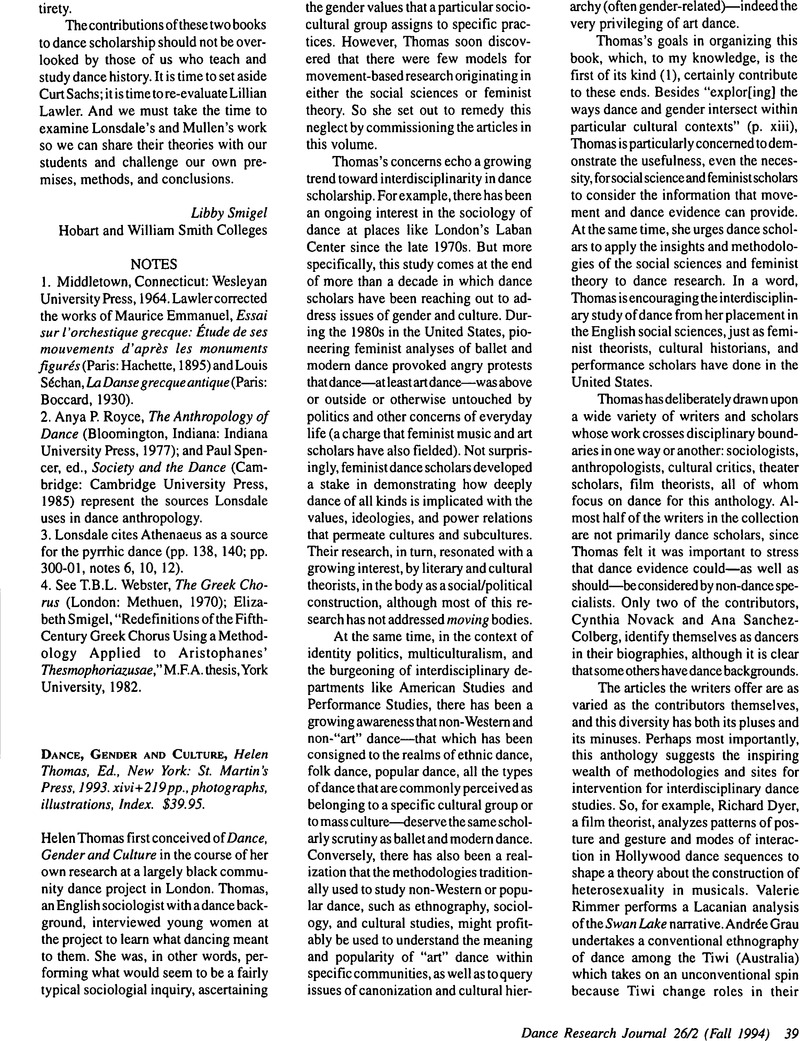No CrossRef data available.
Article contents
Dance, Gender and Culture, Helen Thomas, Ed., New York: St. Martin's Press, 1993. xivi + 219 pp., photographs, illustrations, Index. $39.95.
Published online by Cambridge University Press: 22 July 2014
Abstract

- Type
- Reviews
- Information
- Copyright
- Copyright © Congress on Research in Dance 1994
References
Notes
1. A related, but differently focused, project was the two-part “Feminist Ethnography and Performance” volume of Women & Performance (vol. 5, nos. 1–2), edited by Slyomovics, Susan and Burns, Judy.Google Scholar
2. See, for example, a number of recent American dissertations and theses that look at dance through feminist theory and/or gendered cultural analysis, such as Manning's, Susan Ecstasy and the Demon: Feminism and Nationalism in the Dances of Mary Wigman (Berkeley: University of California Press, 1993)Google Scholar; as well as the following works, as yet unpublished: Albright, Ann Cooper, Mining the Dancefield: Feminist Theory and Contemporary Dance (Ph.D. diss., New York University, 1991)Google Scholar; Daly, Ann, Done Into Dance: Isadora Duncan and America (Ph.D. diss., New York University, 1993)Google Scholar; Tomko, Linda, Women, Artistic Dance Practices and Social Change in the United States (Ph.D. diss., University of California at Los Angeles, 1991)Google Scholar; Burns, Judith F., “Niobe and the Amazons: Women's Performance of American Delsarte” (M. A. thesis, New York University, 1989)Google Scholar. See also work by Leslie Satin, Lynn Garafola, Jane Desmond, and Jane Cowan, as well as a longer tradition of American dance scholarship that looks more generally at women, dance, and culture, such as Elizabeth Kendall, Where She Danced, Nancy Ruyter, Reformers and Visionaries, Deborah Jowitt, Time and the Dancing Image, to name just a few examples.
3. Deidre Sklar pointed out this further ethological derivation of the term to me.
4. Such imprecision conspires with some traditional rhetoric in modern dance and dance anthropology that, since the turn of the century, has posted a universal dance “instinct” that is present in all cultures. While this rhetoric helped to legitimize early modern dance by placing it in a broader frame of reference, it also set up a universalizing, relativist schema that limits our understanding of the dimensions of cultural complexity and hegemony, and the effects of mass culture and issues of representation on both pre-industrial and complex industrial societies. Unfortunately, this rhetoric persists in some dance writing and education today.


